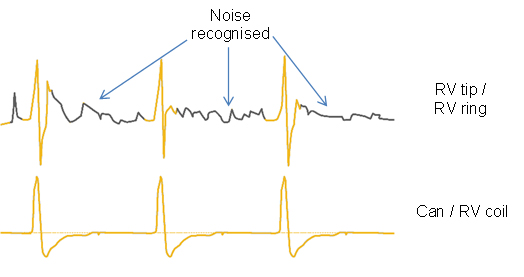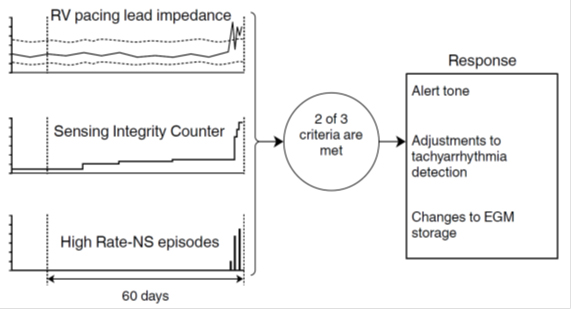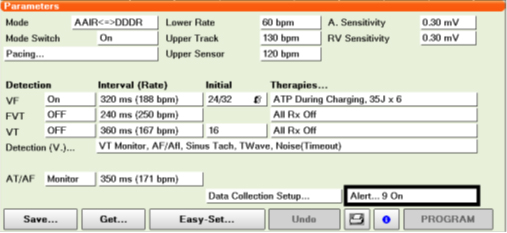Audible alerts or How to make the ICD more efficient and the patient safer
Posted: November 22, 2012 Filed under: Medical Devices | Tags: Audible alerts, ICD, RV Lead Integrity Alert, RV pacing lead Leave a commentAn ICD is saving lives. It gives peace of mind to our patients thinking that at any moment, if their heart stops “someone” will be there to “bring it back”. Taking in consideration that most people who experience a sudden cardiac arrest do not survive the first event, the ICD is one of the great medical inventions of the 20th century.
In order for the ICD to treat the ventricular arrhythmia it needs to accurately detect them. Undersensing and Oversensing are the two significant problems affecting the detection in an ICD.
There are also 2 categories of situations in which the patient should be notified: if his clinical condition is getting worse and if the system’s functionality is in danger. In big majority of cases the ICDs are reliable devices but, sometimes a part of the system can break and in those moments it is extremely important to warn the patient immediately in order for him to contact his physician as soon as possible. This is particularly true when the integrity of the defibrillation lead is threatened.
Soon after the implantable defibrillator became the 1st line of defence against the SCD, physicians realised the inappropriate therapies are the biggest complication.
Getting an ICD is an important moment in a patient’s life and for primary prevention it is something difficult for the patient to understand “Why do I need a device when I never had a cardiac arrhythmia before?” Now, imagine this patient after getting his primary prevention ICD starting a home activity where he is using his arm a little more than before, like playing tennis with his son. Imagine that after a few days he starts receiving inappropriate shocks. He’s been told the ICD is there to save his life but in exchange he’s passing in pain because of it. This is just an unfortunate event but it is the reason why in NayaMed we have implemented a number of clinical and device alerts specifically designed to warn the patients about potential problems.
The ICD leads are complex medical devices and all the manufacturers are seriously testing them before the market release but with all this, a problem can appear. In those situations the NayaMed ICD will start ringing an alarm at constant intervals and it is among the only devices in the market that will ring daily, until a physician is checking the device.
As the right ventricular lead problems represent the major complication in the ICD, NayaMed has 3 separate analysis and alerts aiming to detect a possible RV lead problem.
The constant impedance check is the classical alert that will ring if the impedance value goes out of certain ranges, but NayaMed ICD can do much more…
The Lead Integrity Alert is probably one of the most ingenious and useful alerts on the market. It is monitoring the important variations in the lead impedance, the short not-physiological ventricular intervals (close to the ventricular blanking) and highly rapid non-sustained ventricular events (that could be due to a lead rupture and not to real heart contractions). It integrates the information from those 3 parameters in the following way:
- An RV pacing lead impedance measurement is less than 50% or greater than 175% of the baseline impedance. The baseline measurement is the median of the previous 13 daily measurements.
- The ventricular Sensing Integrity Counter is incremented by at least 30 within a period of 3 consecutive days or less.
- The device senses 2 High Rate-NS episodes with a 4-beat average R-R interval of less than 220 ms.
If at least 2 of the following criteria have been met within the past 60 days, it identifies a potential lead fracture.
When the criteria for the RV Lead Integrity Alert are met, the device immediately sounds an alert tone. The tone sounds again every 4 hours beginning at the next scheduled 4-hour time interval. The tone also sounds at the programmed Alert Time and when a magnet is placed over the device.
What is important is in the NayaMed ICD, the tone continues to sound until the device is interrogated by a programmer.
Using this alert, in case of a lead fracture, the patient will receive a 3 days warning* before the inappropriate shocks start. As mentioned in the graph, it is not a simple alert but it also takes some proactive actions to minimize the consequences of a broken lead and help to diagnose it.
One of the newest alerts on the device market is the RV lead noise which is actually differentiating between noise and a real VT/VF event. When VT/VF detection is withheld due to lead noise and the RV Lead Noise Alert is on, the device sounds a patient alert tone. This tone then sounds every 4 hours beginning at the next scheduled 4-hour time interval. The alert tone also sounds at the programmed Alert Time and when a magnet is placed over the device.

The Important aspect… the alert tone continues to sound until the device is interrogated by a programmer. As the previous one, it is not only an alert but also a discriminator preventing the inappropriate shocks due to noise.
VF Detection or VF Therapy OFF, low battery voltage and the excessive charge time are also 3 alerts warning the patient that he/she should consult his physician as soon as possible.
All the device alerts are nominally switch ON so basically we can say that if the system has a hardware problem… the patient will be notified.
The physician also has the possibility to program the alert time in respect with patient preferences and activity.
In addition to those important device alerts there are 2 clinical alerts helping the physicians to better manage the patients; in case the number of shocks delivered in a VT/VF episode is greater than or equal to the programmed Number of Shocks Threshold and if a specific VF, VT, or FVT episode was redetected after all programmed therapies for that type of episode were delivered.
All the alerts can be easily programmed from the Alert button on the Parameter screen.
Analysing all those aspects we’re happy to say that the NayaMed ICD has probably one of the biggest range of audible device alerts that will constantly monitor the system and ring when necessary. They work not only with the NayaMed leads but with any compatible lead on the market making the ICD a better lifesaver.
*Swerdlow CD, Gunderson BD, Ousdigian KT, Abeyratne A, Sachanandani H, Ellenbogen KA. Downloadable Software Algorithm Reduces Inappropriate Shocks Caused by Implantable Cardioverter-Defibrillator Lead Fractures. A Prospective Study. Circulation. Published online September 27, 2010.
Alexandru Trif





